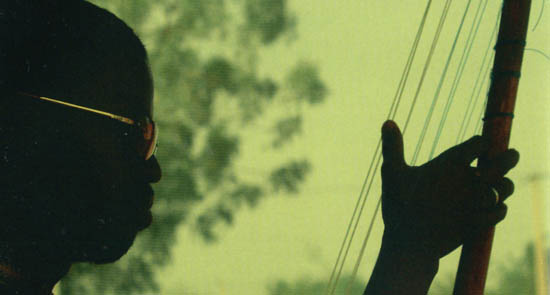|
Vieux Kanté
|
|

Vieux Kanté
His instrument, a direct descendant of the donson n'goni, which is not only larger, but relegated to hunter's ceremonies, was first introduced in the 1960s as a way to free players from formalities associated with the larger harp. It caught like wildfire in the Wassoulou region of SW Mali, and a young Kanté, blind since age 12, took to it instead of working the fields, copying patterns heard on the radio, and slowly adding strings to broaden his palette, eventually doubling the instrument's traditional 6-string design. And his music is a far cry from the minimalist plucking of the donson; his local club appearances surely made that clear.
One clip in particular finds him alone inside his house, playing a nearly 12-bar pattern, his hands up and down the harp, spitting out notes that sound nearly metallic, but never losing the groove. It was clear he was taking this instrument into some unchartered territory. In the years just prior to his death, he was leading a six piece band- trap kit, electric bass, hand percussionists, and vocalists- and it's this ensemble one hears here. Professionally recorded in a Bamako studio, the band is polished, and the recordings have the sheen that would have certainly thrust him onto stages in Europe and elsewhere, had he lived.
Yet, this kind of “ready for the world” polish can often detract from the music's essence, and by the time the band hits into a generic reggae groove with “Nafola,” that has indeed happened.
It's too bad, as the opening track, “Sans Commentaire,” with its minimal support, does such an amazing job of showing off its leader's ability. But regardless of how one hears production values, Kanté is also an excellent vocalist, and alongside Kabadjan Diakite, who is interviewed in the liner notes, the two weave spells with their harmonies.
Ultimately, for anyone who digs Malian music, or just likes a good groove, this record is an fantastic example of what this massive land-locked West African nation has to offer musically, and Kanté is finally getting some much deserved, if belated attention outside his home. - Bruce Miller
The CD is available from cdRoots
© 2016 RootsWorld. No reproduction of any part of this page or its associated files is permitted without express written permission.
|
|
|
|